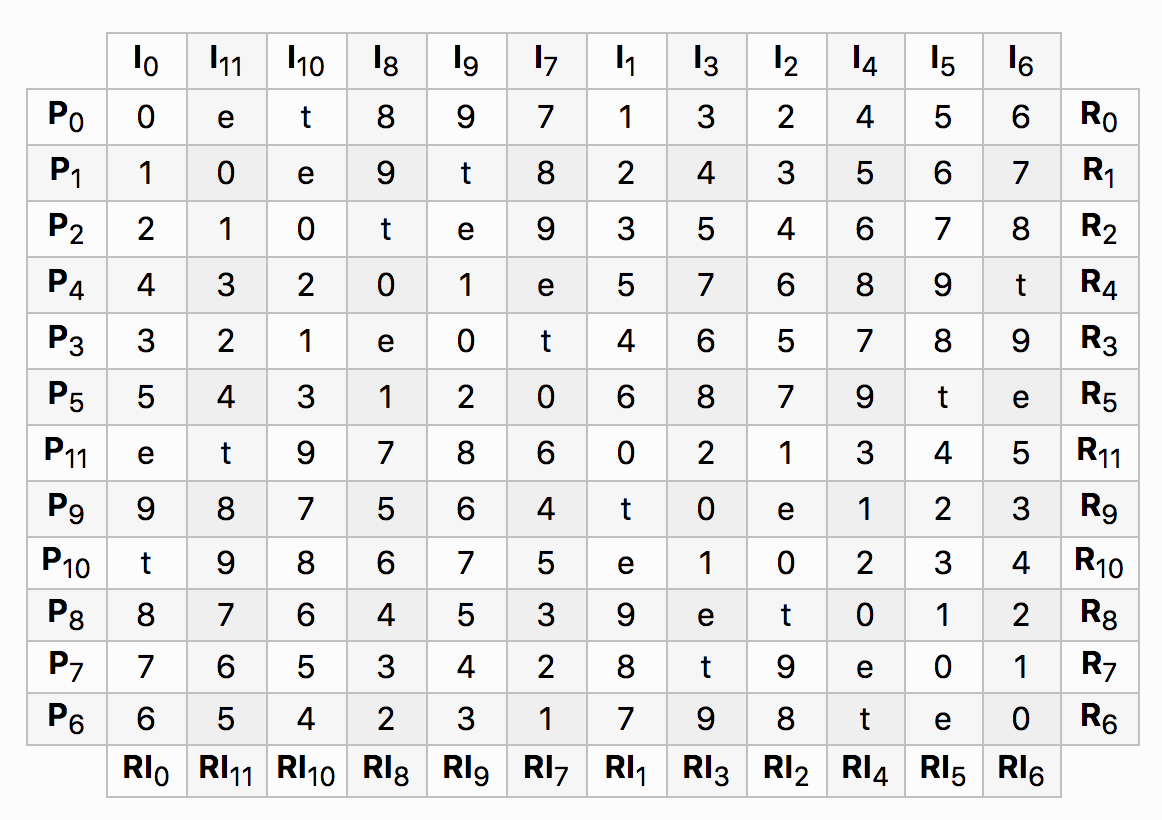This is a very interesting question and ended up being a fun maths puzzle to solve. I solved numerically and found 3840 matrices which satisfy this condition.
Here is one of them:

Pat Muchmore pretty much hit the nail on the head with the necessary conditions in his answer. But I thought I'd walk through how you'd solve this mathematically.
Firstly, instead of putting note values in the 12-TET matrix, let's put interval values above the root.
So instead of the first row looking like:
1, 3, 6, 10, 4, ...
We can write it as:
1, 1+2, 1+2+3, 1+2+3+4, 1+2+3+4+6, ...
(Note that we are working in a mod12 system, so the last element of the second list here 1+2+3+4+6=16. But 16 mod 12 is 4, which is the last element of the first list.)
Also, let's write it more formally, and make no assumptions about values. If we start on x, in 12-TET we have the first row:

It's starts out ugly, but the general strategy is to figure out relations between these intervals to try to reduce them down. From this first row we can construct a full matrix. Here it is (with only 1st row, 1st column, and diagonals completed).

If you follow down the NE-SW diagonal from the top, a pattern emerges that when you move down you must remove the latest interval added (k), and when you move left you remove the earliest interval added (a). In other words, remove intervals in pairs: (a,k); (b,j); etc. Our goal is that every value in this diagonal is the same, so the only way to remove a pair of intervals and not change the value is if their sum is 12.
Therefore: a+k=12, b+j=12, etc. If you play around with some values, you'll see that this is exactly the palindrome behaviour observed. In fact, I rather say the condition is not that there must be a palindrome, but that pairs of outer intervals must sum to 12.
When we get to the center, we have x+f and x-f, which must be equal. The only way these can be equal in a mod12 system is when f=6. Great, now we know this interval, and we know for certain the diagonal must only contain x+6 in each cell.
We can also infer what the first element of the first row is. The top right cell is x+a+b+...+k, and this =x+6. The bottom left cell is x-a-a-...-k, and this =x+6. So we have the relation:
x+a+b+c+d+e+f+g+h+i+j+k = x-a-b-c-d-e-f-g-h-i-j-k. But we already know a+k=12, which = 0 in mod12. We can remove. Similarly for -a-k=-12=0. In fact we can do this for all out interval pairs until we have x+f = x-f = 6. This is only true when x = 0.
Once we have this, we know our diagonal contains x+f=0+6=6 in each cell. One last little bit of notation to improve on; instead of holding onto a,b,c,d,e,f,g,h,i,j and k. Let's use our knowledge of how the pairs must sum to 12 to rename each interval a,b,c,d,e,6,12-e,12-d,12-c,12-b,12-a.
The problem is now reduced to five parameters, and the current matrix row looks like:
 This is ugly, until we realize we can cancel a lot of stuff (a-a=0, 12=0, etc), so we can simplify to:
This is ugly, until we realize we can cancel a lot of stuff (a-a=0, 12=0, etc), so we can simplify to:

Where we are now is very close to the end. These are the minimum required conditions to find a 12-TET matrix with a both diagonals constant. The goal from here is to construct a row such that each tone only appears once, and the intervalic relationships provided are observed. So long as the first interval is, for example, a=7, then the second last row element must be 6+7=1, and so on.
I couldn't come up with any further parameterizations that helped, or any more tricks. From here I brute forced it by constructing all possible rows that satisfied all the conditions.
This all moved very far away form music, but I had fun so thanks for the problem!







